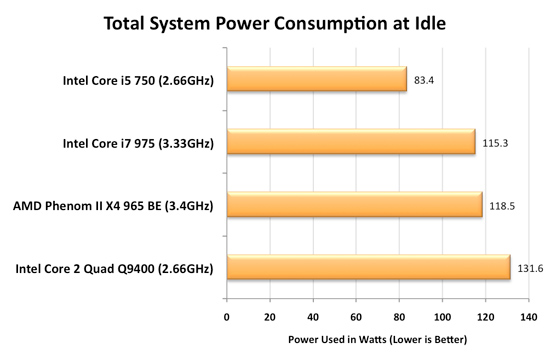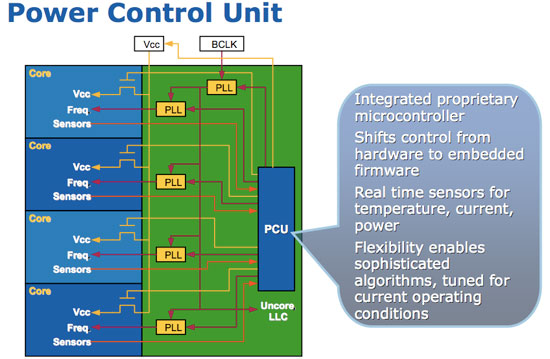Intel's Core i7 870 & i5 750, Lynnfield: Harder, Better, Faster Stronger
by Anand Lal Shimpi on September 8, 2009 12:00 AM EST- Posted in
- CPUs
Homework: How Turbo Mode Works
AMD and Intel both figured out the practical maximum power consumption of a desktop CPU. Intel actually discovered it first, through trial and error, in the Prescott days. At the high end that's around 130W, for the upper mainstream market that's 95W. That's why all high end CPUs ship with 120 - 140W TDPs.
Regardless of whether you have one, two, four, six or eight cores - the entire chip has to fit within that power envelope. A single core 95W chip gets to have a one core eating up all of that power budget. This is where we get very high clock speed single core CPUs from. A 95W dual core processor means that individually the cores have to use less than the single 95W processor, so tradeoffs are made: each core runs at a lower clock speed. A 95W quad core processor requires that each core uses less power than both a single or dual core 95W processor, resulting in more tradeoffs. Each core runs at a lower clock speed than the 95W dual core processor.
The diagram below helps illustrate this:
| Single Core | Dual Core | Quad Core | Hex Core | |
| TDP |  |  |  |  |
| Tradeoff |  |  |  |  |
The TDP is constant, you can't ramp power indefinitely - you eventually run into cooling and thermal density issues. The variables are core count and clock speed (at least today), if you increase one, you have to decrease the other.
Here's the problem: what happens if you're not using all four cores of the 95W quad core processor? You're only consuming a fraction of the 95W TDP because parts of the chip are idle, but your chip ends up being slower than a 95W dual core processor since its clocked lower. The consumer has to thus choose if they should buy a faster dual core or a slower quad core processor.
A smart processor would realize that its cores aren't frequency limited, just TDP limited. Furthermore, if half the chip is idle then the active cores could theoretically run faster.
That smart processor is Lynnfield.
Intel made a very important announcement when Nehalem launched last year. Everyone focused on cache sizes, performance or memory latency, but the most important part of Nehalem was far more subtle: the Power Gate Transistor.
Transistors are supposed to act as light switches - allowing current to flow when they're on, and stopping the flow when they're off. One side effect of constantly reducing transistor feature size and increasing performance is that current continues to flow even when the transistor is switched off. It's called leakage current, and when you've got a few hundred million transistors that are supposed to be off but are still using current, power efficiency suffers. You can reduce leakage current, but you also impact performance when doing so; the processes with the lowest leakage, can't scale as high in clock speed.
Using some clever materials engineering Intel developed a very low resistance, low leakage, transistor that can effectively drop any circuits behind it to near-zero power consumption; a true off switch. This is the Power Gate Transistor.

On a quad-core Phenom II, if two cores are idle, blocks of transistors are placed in the off-state but they still consume power thanks to leakage current. On any Nehalem processor, if two cores are idle, the Power Gate transistors that feed the cores their supply current are turned off and thus the two cores are almost completely turned off - with extremely low leakage current. This is why nothing can touch Nehalem's idle power:

Since Nehalem can effectively turn off idle cores, it can free up some of that precious TDP we were talking about above. The next step then makes perfect sense. After turning off idle cores, let's boost the speed of active cores until we hit our TDP limit.

On every single Nehalem (Lynnfield included) lies around 1 million transistors (about the complexity of a 486) whose sole task is managing power. It turns cores off, underclocks them and is generally charged with the task of making sure that power usage is kept to a minimum. Lynnfield's PCU (Power Control Unit) is largely the same as what was in Bloomfield. The architecture remains the same, although it has a higher sampling rate for monitoring the state of all of the cores and demands on them.
The PCU is responsible for turbo mode.










343 Comments
View All Comments
Griswold - Tuesday, September 8, 2009 - link
You definitely ARE stupid.dragunover - Tuesday, September 8, 2009 - link
Readers aren't, but you didn't read...snakeoil - Tuesday, September 8, 2009 - link
wow, this lynnfield is expensive, and the motherboards are expensive too.this is a crippled core i7 and you will have problems because the northbrige only have 2 x 8 pcie express electrical.
so if you are going to buy a new directx 11 video card don't commit the mistake of buying a lynnfield which is crippled.
without hyperthreading in some cases is a 40% slower than core i7
Eeqmcsq - Tuesday, September 8, 2009 - link
Anand, can't you just ban this guy? He's always trolls against Intel here, TechReport, and a couple other tech sites.JonnyDough - Tuesday, September 8, 2009 - link
I second the notion.Chlorus - Tuesday, September 8, 2009 - link
Thirded.maddoctor - Tuesday, September 8, 2009 - link
Your comment will not affect people whose committed to bought these. I think it is more valuable than any AMD platform. I don't think AMD will survive next year.TA152H - Tuesday, September 8, 2009 - link
From a purely processor perspective, I'd agree, but AMD platforms are pretty strong when you compare IGPs. The G45 compared to the 790GX is worse comparison than the Phenom II compared to the Nehalem.Don't forget IGPs are a HUGE market, so it's not an unimportant consideration.
PassingBy - Tuesday, September 8, 2009 - link
Yes, the IGP market is huge and Intel dominates that market as it is. If Intel can get its drivers right, then it looks like the IGP on Clarkdale/Arrandale will extend that domination. If you want to game seriously on graphics intensive games, then don't use an IGP.ash9 - Tuesday, September 8, 2009 - link
broaden your horizons; the real money is in corporate retooling- that said AMD's platform is without question offer more bang for the buck, considering corporate needs...most corporate folk have gone blind because of Intel's IPG's (laptops and desktops)Anand how bout running the tests that addresses that issue (IPG's and eye strain)